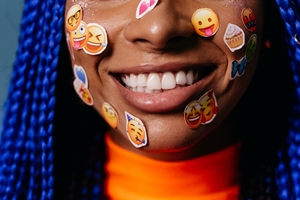How to Use ChatGPT for Branding Strategy Development & Content Creation

Supercharge your branding strategy with ChatGPT's AI capabilities.
-
Tip #2: Need New Content? Ask ChatGPT to Help With Content Creation!
-
Tip #3: How to Build a ChatGPT Chatbot That Serves Your Customers
-
Tip #5: Use ChatGPT to Bring Consistency to Your Brand Voice
-
Tip #7: Reach More of Your Target Audience With ChatGPT's Personalized Content Creation
-
Tip #8: Leverage ChatGPT to Generate Compelling Stories for Your Marketing Strategy
-
Key Takeaway: ChatGPT for Brand Strategy Development, There's No More Versatile Tool!
Over the past year, Artificial Intelligence (AI), and particularly ChatGPT, has emerged as an incredibly powerful tool for businesses.
From developing relevant content that speaks directly to your target audience, to drafting dozens of social media posts in mere seconds, today, it seems there's almost nothing these natural language processing tools can't do!
Curious how your business can start using generative AI to create copy that captures your customers' attention—and boosts your sales? Read on!
In this article, we'll cover what AI means for your marketing strategy, plus eight helpful ways you can use this powerful tool to strengthen your brand strategy.
Let's begin!
What is ChatGPT?
ChatGPT (also called Chat GPT) is an AI tool developed by Open AI that is revolutionizing how brands generate content, ideas, product descriptions, website copy, and more. And best of all, this great tool is free!
The "GPT" in ChatGPT stands for Generative Pre-Trained Transformer. Pre-trained means the tool was taught how to respond to prompts using vast amounts of text data and training data. As a result of that incredible amount of data, ChatGPT has a conversational interface that makes it easy to type prompts directly into its text box and receive unique answers in seconds.
This new technology opens up a world of possibilities for small businesses and entrepreneurs, empowering them to craft new brand collateral, content, and copy that sends the right message—without going through the time-consuming process of endless ideation.
Tip #1: How to Use ChatGPT for Brand Strategy Development
Your business' brand strategy is a foundational element of your brand—and essential for your long-term success. Without a brand strategy in place, your brand positioning can become vague or confusing, and your customers may struggle to relate to your brand.
But with a clear, firm brand strategy created with your target audience in mind, you can stand out from the competition—and build valuable brand equity in the process.
To make a new brand strategy, start with your business' basic information
To use ChatGPT for brand strategy development, start by prompting the model with specific information about your business, target audience, current marketing campaigns, and your customers' biggest pain points.
By providing this information before you use ChatGPT to generate ideas, you can leverage the tool's ability to generate creative and tailored ideas!
Once you've input a few details about your positioning, ask ChatGPT for brand strategy suggestions using questions like:
- "What are some unique ways to communicate our brand values of innovation and sustainability to our audience?"
- "How can we keep our brand's voice consistent across all every element of our marketing strategy?"
- "What are a few different ways we can communicate our unique selling proposition?"
These prompts are just a starting point when it comes to using ChatGPT to develop your brand strategy and guide your marketing efforts. And remember, you can always try a different ChatGPT prompt if you don't get what you need the first time!
Tip: Read our guide How to Build a Brand: Branding 101 to learn more about creating an effective brand strategy!
Tip #2: Need New Content? Ask ChatGPT to Help With Content Creation!
Valuable, educational, and informative content is an essential part of every successful business' marketing strategy. From your blog posts and email marketing, to your social media captions and ad copy, it can feel like content marketers' jobs are unending!
And that's what makes ChatGPT's content generation abilities so valuable.
Try these prompts to use ChatGPT to generate content ideas for your digital marketing campaigns
To use ChatGPT for marketing content, start by giving the tool some information about your business, customers, and what type of customer engagement you hope to generate. That allows the tool to mimic your brand messaging and voice as it provides content and ideas.
For example, try entering a ChatGPT prompt like "What are some blog post ideas that align with our brand's mission of empowering small businesses?" or "Can you suggest creative social media content ideas that reflect our brand's fun and energetic personality?"
Always review and refine ChatGPT's outputs!
ChatGPT's ability to interpret simple questions like this, and provide answers that align with your tone and brand, should serve as the starting point or source of your inspiration. As a human content creator (and industry expert!) you can refine and tailor these ideas to suit your business and your creative touch.
While it may be tempting to use ChatGPT's outputs directly on your social media platforms, ad copy, website copy, and more, it's important to remember that the tool is just that—a tool! And is no replacement for industry experts or detailed research.
Tip #3: How to Build a ChatGPT Chatbot That Serves Your Customers
Did you know you can use ChatGPT to create a custom chatbot for your website? Whether you have an ecommerce store where customers are constantly asking product-related questions, or a portfolio website that shows the creative work your agency does, a custom chatbot can instantly improve your total website experience—and make your business stand out.
A chatbot is a built-in conversational tool that can enhance customer service, gather real-time customer feedback, and boost the lead generation efforts of just about any website, in any industry. And with ChatGPT's powerful capabilities, you can create one for yourself—without the hassle of full web development!
Here's how to use ChatGPT to create a custom, on-brand chatbot for your website
Using ChatGPT's conversational capabilities, you can train the AI to understand and respond to common customer inquiries. By providing a set of predefined responses and prompts that reflect your business' brand tone and values, you can ensure the chatbot interacts with your website visitors in a consistent and engaging manner.
Start by defining the typical questions or concerns your customers may have. For example, in the B2B space, common queries might revolve around pricing, product features, or technical support.
As you feed these questions into ChatGPT, and associate them with appropriate responses, you can begin to train the AI tool to provide accurate and helpful information that aligns with your brand message and voice.
Once you've added Open AI's special API for chatbots into your chosen chatbot plugin, the AI can learn from real-time customer interactions on your website—and continuously improve its responses over time.
Tip #4: Leverage AI to Give Your Products Buy-Worthy Names
Your product name is often the very first thing your customers learn about what you have to offer. It's a key piece of your overall product marketing strategy, and it has the potential to make (or break!) your sale. No pressure, right?!
Luckily, with the right set of prompts and a little editing, you can come up with both product names and product descriptions that give potential buyers more clarity into what you offer—and why they should want it.
When generating product name ideas, try a combination of emotions, descriptions, and formats
To use ChatGPT to create product names that align with your brand, resonate with your customers, and leave a lasting impact, provide a bit of information about the product you want to name.
Details like the product's features and benefits are a good starting point. You can also talk about what the product looks like, what makes it different, and who might buy it.
ChatGPT can provide a seemingly endless number of possible titles for your product, ranging from combination names that mix two words into a unique new name, to ultra-clear titles that leave no question of what the product is used for.
Try playing with creative name ideas, combinations of words, and styles until you've generated a memorable name that captures the essence of your product.
Try these prompts to generate new product names:
- "Can you suggest product names that convey our brand's commitment to innovation and sustainability?"
- "What are some creative product name ideas that evoke a sense of trust and reliability?"
- "What are some unique product names for (enter short description of your product) that would appeal to my audience of (enter a bit of customer data)?"
- "What are some names related to (enter current product name) that imply a more premium version of this product?"
Once you've chosen the best names, you can even use ChatGPT to generate product descriptions that match the name, audience, and your tone.
As always, before you choose a name, double-check that the product name isn't already trademarked, that it is descriptive and positive, and that it aligns with your creative vision.
Tip #5: Use ChatGPT to Bring Consistency to Your Brand Voice
Did you know you can use ChatGPT to edit and refine your current content? The tool does more thancreatecontent, it can also provide valuable improvements to your sales copy, Google ads campaigns, marketing materials, and more!
ChatGPT does more than create—it can edit, too!
To leverage ChatGPT for marketing refinements, just input some information about your branding strategy, your preferred tone, your existing message, and your communication style. You can even add a few examples of social media posts or website copy that convey the best version of your message.
As you converse back and forth with the tool, ChatGPT can analyze your brand's messaging patterns, identify recurring themes, and offer insights on how to make your communication more cohesive and impactful.
For example, you can ask questions like, "How can we infuse our brand voice with more authenticity and relatability?" or "Can you suggest ways to make our brand messaging more engaging and conversational?"
In response, the tool will help you make more informed decisions about what content to keep, what sections to rework, and what marketing collateral to build from the ground, up.
Tip #6: How ChatGPT Can Improve Your Customer Experience
Looking to strengthen your customer experience, beyond offering a trainable chatbot? ChatGPT can help!
Whether you're looking to find—and fix—the friction points in your customer journey, or to come up with creative ways to surprise and delight customers at various touch points, ChatGPT can offer fresh suggestions that position your business for success.
Try these prompts to improve your business' customer experience
As with every ChatGPT tip, the better information you provide up front, the better output you'll receive. And looking for opportunities to create memorable moments for your target audience is no different.
To provide ChatGPT with information to process, try sharing a bit about your business' background, your sales process, your customer's feedback, and a competitor analysis of a few other businesses in your field.
Then, try using these prompts to get the inspiration flowing:
- "How can we personalize our interactions with customers to create a more tailored experience?"
- "What are some ways to enhance our onboarding process and make it more seamless for new buyers?"
- "Can you suggest strategies to improve our response times and overall customer support efficiency?"
- "What marketing strategies can we use to accelerate our customer's decision-making process?"
Tip #7: Reach More of Your Target Audience With ChatGPT's Personalized Content Creation
In today's ultra-competitive market, one of the quickest ways to stand out is to personalize your marketing.
Shoppers are used to curated lists, targeted social media ads, and highly relevant browsing experiences. So why should your business be different!
Use your customer persona to create personalized—and professional—content
To leverage ChatGPT to create more personalized content, start by inputting your ideal customer's preferences, behaviors, and specific needs. The best way to share this information (and to gather it for your own reference!) is to complete a detailed customer persona.
Once you have your persona completed, share that information with ChatGPT. You can ask for suggestions for how to strengthen your email marketing, restructure your next Google ads campaign, update your website, and even target specific customer types on social media!
No matter where you choose to use your new content, ChatGPT can help you make every customer feel understood and valued.
Tip #8: Leverage ChatGPT to Generate Compelling Stories for Your Marketing Strategy
Do you ever wish you could communicate the impact of your brand using clear, visual examples that resonate with your target audience?
With the right set of prompts and ChatGPT, you can!
ChatGPT's story-based insights are the basis for truly engaging content
ChatGPT can offer story ideas, relatable examples, potential plot lines, and unique perspectives that can shape your brand's narrative. Rather than overwhelming your customers with benefits and product details, the stories ChatGPT can help you tell give you a fresh way to articulate your brand's journey, values, and purpose, while connecting with your audience on an emotional level.
Plus, because you can tell the AI tool all about your brand positioning, it can help you create consistent and cohesive storytelling across every marketing channel you pursue—including your website, social media content, blog posts, case studies, and video scripts.
ChatGPT can even help you explore different storytelling formats and mediums, such as interactive experiences, podcasts, or immersive content, that can further enhance your brand narrative—and capture your audience's attention in new and exciting ways.
Key Takeaway: ChatGPT for Brand Strategy Development, There's No More Versatile Tool!
Leveraging the power of AI, and specifically ChatGPT, for brand strategy development has never been easier for small businesses and entrepreneurs.
From generating brand messaging ideas to enhancing your content ideation process, to creating your own chatbot, naming your products, and more, there's no question ChatGPT is revolutionizing how we approach branding!
Whether you're a new brand just beginning your journey, or a seasoned brand ready for a refresh, don't underestimate the potential of AI—and how it can take your branding to new heights.


